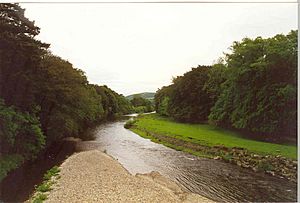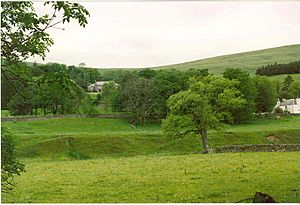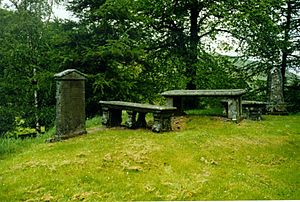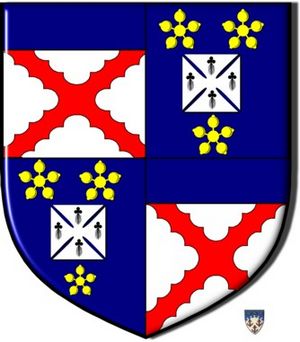Clan Tweedie facts for kids
The Tweedie or Tweedy name belongs to a Scottish clan. A clan is a group of families, often with a shared ancestor and a common name. The Clan Tweedie does not currently have a chief who is officially recognized by the Lord Lyon King of Arms. This means they are considered an Armigerous clan, which is a clan that doesn't have a recognized chief. However, the Tweedie name is also seen as a sept (a family associated with a larger clan) of the Clan Fraser. The name Tweedie comes from the lands of Tweedie, which were located along the River Tweed valley in Peebleshire, part of the Scottish Borders.
Quick facts for kids Clan Tweedie |
|||
|---|---|---|---|
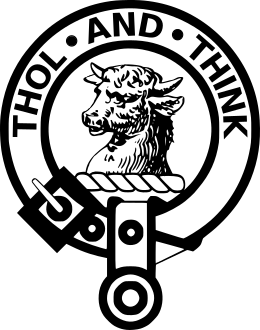
Crest: A bull's head.
|
|||
| Motto | "Thol and Think" ("Thole" is an old Scottish word meaning "suffer" or "endure"). | ||
 |
|||
| Clan Tweedie has no chief, and is an armigerous clan | |||
|
|||
|
|||
Contents
History of the Tweedie Clan
How the Clan Began (A Mythical Story)
Scottish stories say the Tweedie name came from a water spirit in the River Tweed. The legend tells of a husband who went to fight in the crusades (religious wars). While he was away, his young wife became pregnant. When he returned, he found he had a son. His wife explained that she had gone to the River Tweed and a fairy from the river had made her pregnant. Her husband believed this story, but only if their son kept the surname Tweedie. Whether this fairy tale is true or not, the family name definitely came from the lands near the River Tweed.
Early Days of the Tweedies
The Tweedies were known as a strong and powerful family. Their main home was at Drumelzier in Tweeddale. The first Tweedie recorded was John de Tueda, who lived during the time of King Alexander II (1214–1249). He later received an official document from King Alexander III (1249–1286), confirming his ownership of lands on the River Tweed. Even back then, the family had many connections and owned a lot of land.
In 1296, Finlay de Twydyn swore loyalty to King Edward I of England. His son, Roger of Twydyn, received the house and lands of Drumelzier around 1320. The family kept these lands for over 300 years. A historian named Chambers described the Tweedies as a "savage race." Another writer in the 1700s called them a "powerful and domineering family."
The Tweedies of Drummelzier
Until the 1600s, the main center for the Tweedie family was Drummelzier. Other parts of the family lived in places like Wrae, Stobo, Dreva, and Fruid. They also lived in other forts and peel towers (small defensive towers) along the valley.
The early history of the Tweedies was often marked by conflicts, which was common in the Scottish Borders at that time. They had serious disagreements with neighboring families, especially the Veitch's. The Tweedies would sometimes charge fees for travelers passing through their land. They were also sometimes involved in cattle rustling (stealing cattle) or fights, often in the streets of Edinburgh.
A big event happened in 1524. A large group of Tweedies were involved in a dispute with Lord Fleming (the chief of Clan Fleming). This led to Lord Fleming's death and the capture of his son, Malcolm Fleming, 3rd Lord Fleming. The argument was about Malcolm's plan to marry Catherine Fraser, who actually ended up marrying James Tweedie of Drummelzier.
In 1592, another James Tweedie of Drumelzier was accused of being involved in the death of Geddes of Glenhegdon in Edinburgh. People complained that it was unclear how many conflicts James Tweedie and his friends had been involved in. The old rivalry with the Veitches sometimes flared up again. In 1611, King James noticed this ongoing conflict. One of his last actions before moving to England was to visit the Upper Tweedale area to try and stop this bloody feud. However, a year later, it is said James Tweedie died after a duel with Veitch of Dawick.
The wealth and power of the Drummelzier family began to decrease. In 1633, the last Tweedie of Drummelzier had to sell the lands of Drummelzier to Lord Hay of Yester.
The Tweedies of Oliver
The Tweedies of Oliver Castle came from a younger son of the Drummelzier family. They gained their lands in the Tweedsmuir area from the leader of Torphichen in the 1300s.
In 1524, Thomas Tweedie of Oliver Castle was connected to the death of Lord Fleming (chief of Clan Fleming). This started a serious feud between the two families. Thomas was sent away from Scotland for three years in 1521. His son, William, is said to have been involved in the plan to kill Rizzio, who was a close advisor to Mary, Queen of Scots. William and Adam Tweedie were among the armed men who, led by Darnley, Morton, and others, rushed into the Palace at Holyrood on March 9, 1566. They were involved in the assassination of David Rizzio, the Queen's foreign secretary and musician, in her presence. Afterward, they were called to appear before the King, Queen, and the Secret Council to answer for the crime.
Later, the Tweedies of Oliver became more settled. They were successful landowners. In 1745, the Laird (landowner) at that time, Thomas Tweedie, and other family members were careful to avoid getting involved in the Jacobite rising. This was when Highland clans marched through the valley. However, Thomas Tweedie's positive report about Captain John Burnet of Colonel Grant's Highland Regiment may have helped Burnet receive a pardon later.
Later Generations from Oliver
Thomas Tweedie married Mary Stevenson, daughter of Alexander Stevenson of Venlaw Castle. Their oldest son, James, inherited Oliver. However, this line of the family ended with Lawrence Tweedie (who died in 1837). He left Oliver to his nephew, George Stodart, on the condition that George take the Tweedie surname and combine their family symbols. This Tweedie-Stodart family line has also since ended.
Thomas Tweedie's second son, another Thomas, lived at Kingledoors. He is the ancestor of most of the Tweedies who came from the Oliver line, through his son Alexander. Of Alexander's three sons, Thomas Stevenson Tweedie (1784–1855) became a surgeon in the East India Company. He had one family with an Anglo-Indian wife, whom he later separated from, and another family in Scotland. He bought many old family properties, including Kingledoors, Glenrath, Wrae, and Rachan.
His brother, Maurice Tweedie (1787–1867), was a major general in the Indian Army. He served in the Coorg Campaign and other battles. He also commanded troops in Penang, Singapore, and Malacca. The third brother, Michael Tweedie (1791–1874), was also a soldier. He served in the Royal Artillery during the Peninsular War (1808–14). He married Frances Forbes and moved to Kent, England, starting the Rawlinson Rolvenden family line.
Michael Tweedie's son, another Michael Tweedie (1836–1917), became a major-general in the 1850s. He served during the Crimean War and the Indian Mutiny. His son, Admiral Sir Hugh Tweedie (1877–1951), had a distinguished career in the Royal Navy. He was an aide to King George V in 1925 and retired as an admiral in 1936. However, he was called back to duty when World War II began. He received important honors, including being made a Knight of the Bath, and holding the French Legion of Honour and the Japanese Order of the Rising Sun. Michael Forbes Tweedie, a grandson of the first Michael Tweedie, wrote a book about the Tweedie family history in 1902. Another descendant of the first Michael Tweedie was the naturalist Michael Tweedie, who was the director of the Raffles Museum in Singapore.
Another Tweedie family line, closely connected to Oliver, comes from Alexander Tweedie (who died in 1740) of Nether Minzion, through his son James. James’ son, Alexander Tweedie (1759–1811), moved to Dreva. His son, James Tweedie of Coates, led to families in Scotland and Chicago. A second son, Thomas Tweedie (1760–1848), moved to Patavan and also had many descendants spread out widely.
Many other people named Tweedie, found in Peebles, nearby areas of Peebleshire, and Edinburgh up to the 1800s, were likely branches of the Tweed valley family.
The Tweedys of Essex, England
This branch of the family comes from a George Twedye, born around 1430. Records from the Herald's Visitation (official visits by heralds to record family histories and arms) of Essex in 1558 and 1612 state that he came "from Scotland from a house called Dromelzane." His family symbols (arms) showed a connection to the Frasers. It is not clear exactly how George was related to the Tweedies of Drummelzier.
His great-grandson, William Twedy, died in 1605 and is buried at Little Sampford, Essex. His memorial describes him as a distinguished military leader. He served under Queen Elizabeth in putting down rebellions in northern England. He also served under Lord Baron de Willoughby in France and under the Earl of Leicester in the Netherlands. He was also in charge of military works at Bergen-op-Zoom.
The family stayed in Essex until the 16th century, then moved to Yorkshire before returning to southern England in the 18th century. The family was centered in Bromley, Kent. Colonel George Tweedy of the HEIC lived at Bromley House. John Newman Tweedy lived at Widmore House, and his son, Arthur Hearne Tweedy, lived at Widmore Lodge. The family's connection to Bromley is remembered by Tweedy Road, a street in the center of the town.
Arthur Hearne Tweedy died in 1925 without marrying. The family is now represented by Captain Christopher John Tweedy, who was formerly with the Black Watch regiment.
Other Tweedie Family Branches
In addition to the main Tweedie families mentioned above, Michael Forbes Tweedie's book The History of the Tweedie or Tweedy Family also recorded information about these other family lines:
- The Descendants Of The Rev. William King Tweedie, D.D.
- Tweedy Of Cornwall.
- Tweedie Of New Brunswick.
- Tweedy Of Cloonamahon.
- Tweedie In Quothquan, co.Sligo, Ireland.
- Alexander Leslie Tweedie.
- Tweedie in Dreva and Minzon, and of Coats
- Alexander Gladstone Tweedie.
- Tweedie From Lindores.
- Andrew Tweedie in Edinburgh
- Tweedie in Broughton Mains
See also
- Tweedie
- Tweedy
Tartan
There is no officially registered tartan (a patterned cloth often associated with Scottish clans) for the Tweedie clan. However, members of Clan Tweedie may wear the Fraser tartan because of their historical connection.
As of 2007, seven other Tweedie/Tweedy Coats of Arms (family symbols) have been officially registered at the Lyon Court in Edinburgh.


